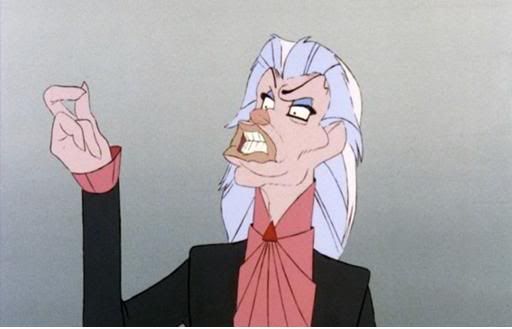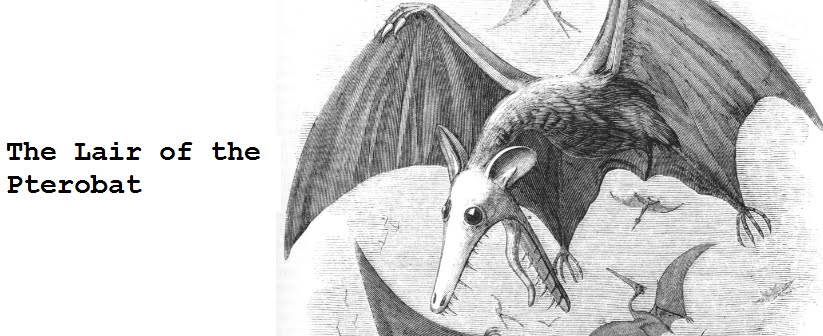
Even after passing through my American-cartoon-hating phase with a renewed interest in home-grown animation, I still find adult-targeted American animated films from the 70s and 80s to be joyless slogs. Making animated films targeted at adults is a good idea, but these movies all seemed to have only the most superficially adult aspects: they have a lot of things kids aren’t supposed to see, but their characters and plot often come off as messy and half-formed, and so I lose interest pretty fast.
All of this is true for
Rock and Rule, the Canadian attempt to make such a film. It has some cool moments and various places where it would be easy to give it more depth, but the overall picture is of an unfinished movie with some cool music and visuals that can’t save it.
Once upon a time,
Rock and Rule was intended to be the flagship production for the Canadian animation studio Nelvana. However, it ended up going far over time and budget, with multiple retoolings: never a good sign. Various factors made
Rock and Rule a commercial failure upon its initial 1983 release, and Nelvana was reduced to having to make children’s animation for the rest of its days.
Yet
Rock and Rule gained a cult following through tape-trading and some television airings, before it finally saw DVD release by Unearthed Films in the summer of 2005. I bought the single-disc edition, and this review will be based on that release and the cut of the movie presented on it.
Rock and Rule is the story of a world following an unspecified war. According to the opening narration, only “street animals” were left, and have evolved into things looking like those dog-snouted people seen as extras in Disney cartoons. These creatures live the urban lives of their predecessors with little apparent change, in grimy but otherwise intact cities.
An ageing and egotistical rock star called Mok (voice of Don Francks, singing voice of Lou Reed) desires to summon a demon from another dimension. He needs a special voice to open the way, and it turns out to belong to a female called Angel (voice of Susan Roman, singing voice of Blondie’s Deborah Harry), a member of a fledgling rock band. After failing to seduce Angel with a promise of advancing her career, Mok resorts to kidnapping to her special voice. The rest of her band, consisting of Angel’s boyfriend Omar (voice of Paul LeMat, singing voice of Cheap Trick’s Paul Zander), and their friends “Dizzy” and “Stretch”, pursue Mok to rescue her, eventually ending up in the centre of the demonic concert.
The problems start with the characters. First off, it’s hard to say who the protagonist is meant to be. Angel spends most of the film being the Girl in Trouble, but the early scenes are told from her perspective, and we often flash back to Angel trying to fight her way out of Mok’s captivity. At the climax, she is also the one who comes up with the solution to banish the demon. On the other hand, Omar is the one who remains free and active throughout, and his character is the one that develops over the course of the movie. In this case, Omar would narrowly win out, but one still feels that Angel is given a lot of the focus, and that in some areas competes with her boyfriend for the protagonist role. It makes the film thus feel undecided as to who the star is, much like Dizzy and Stretch don’t know if Omar or Angel is their lead singer.
Yet Omar’s character arc is lacking. There’s obviously a conflict between Angel and Omar that is set up since the beginning of the film and resolved by the end, as they sing a duet to banish the demon back and then embrace afterwards. However, in between that, one can’t successfully chart the couple’s arc and resolution.
At the start of the movie, Angel tries to get Omar to promise to let her sing one of her own songs at the gig. Omar’s only response is a condescending little smirk and tentative confirmations every time she brings the issue up. When Omar starts into his song, the band’s power is soon cut because the club owner thinks they weren’t good enough. When he gives them another chance. Angel hijacks the show and sings her own song instead, Dizzy and Stretch going along with it while Omar storms off.
Angel is angry with Omar for doing so, and the scene suggests a high level of dysfunction between the characters that is never fully explored. Was Angel justified in hijacking the show, because Omar really wasn’t intending to give her a chance? Or was she rude in taking over the show without preamble? How long was Angel wanting to get her voice into a show? Certainly the music she picks, “Angel`s Song”, suggests someone who has hung in the background and is waiting to be noticed.
Now for all you'll ever know
That you've never seen me
And someday you're gonna show
What your one desire means
Now I'll only set the stage
Focus lights on me
I make sure the power's on
I'm the scenery
Oh, what will the signal be
For your eyes to see me?
Watching off sides as I wait
Just in case you need me?
So I still will set the stage
Send my thoughts to you
I'm receiving every wave
The sound, send love through
Either way they seem to forgive each other, but then Omar develops a jealous complex around Angel when Mok later invites them to his home, as if he is threatened by the possibility of his girlfriend getting any credit, as much as being jealous of the attentions of an older, richer male (neither of which are excuses for acting like a dick). When Angel is kidnapped, Omar even believes Mok’s henchman when they say that she went with Mok of her own accord, abandoning the band.
He persists in acting sullen and cynical regarding Angel even as they move to rescue her, refusing to admit his own concern. There is no turning point, no defining moment at which Omar realizes he was being an asshole and that Angel was being coerced all along.
The closest thing is Dizzy begging Omar to look into his heart and realize that Angel didn’t abandon them, but one never sees Omar’s reaction, and this all happens just minutes before he appears to free Angel--one would think his friends would have a stronger discussion sooner. Without this clear character arc, Omar just comes off as a jackass, and not in a funny or interesting way. On a second viewing, the audience might be tempted to side with Angel’s hijack, and wonder what she actually sees in Omar.
Angel herself isn’t that bad a character; at times she has an air of genuine scruffiness, helped by Susan Roman’s voice acting. As mentioned above, it is still Angel who concludes that her song could be used to send the demon back as well as summon it, and stands over the fallen Omar to begin. It can’t quite excuse scenes of being chained up helplessly before the demon and almost falling out of her top, however.
Because Mok has that villain charisma, one wants him to be a better character. He has a wonderfully creepy design and a smoothly evil speaking voice provided by Don Francs, but is usually reduced to fits of stock villainy or weak parody.
The film vaguely suggests that Mok is summoning the demon to take a suicidal revenge on the masses he believes have spurned him. This is a ridiculous idea in several ways, yet the film never sells the ironic hilarity of this, or even acknowledges that if Mok were successful, his chances of getting back his past fame are reduced to nothing. The scale of his current decline is also never made clear.
The closest thing the film has is Mok remarking that his last concert wasn’t “completely sold out”, but it’s never explained whether that was what pushed him to demon-summoning, either in terms of it being humorously ridiculous or in just substituting for a more believable crisis. Instead, Mok is played just as an otherwise unremarkable villain who just happens to be a rock star, and thus is less interesting than if his motivations were better defined, and were tied only to personal matters such as the urge to burn out rather than fade away.
In addition, sometimes the film also suggests that Mok is not after mere destruction, but wants to summon the demon to gain some nebulous power, further muddying the film. Whether cackling in his jumpsuit and goggles about his results, or then screaming at the demon to “Destroy them all!” Mok is pure cheese, pure childish caricature, and
Rock and Rule doesn't’ seem sophisticated enough to mean this ironically. Mok doesn’t even understand what his computer actually means when it says there is “no one” who can stop his demon: the truth is that two powerful voices singing in harmony can stop the beast, but Mok only thinks he has it sewed up. It’s a writing conceit that would be at home in the children’s cartoons
Rock and Rule is meant to subvert.
(Also, where does Mok get all this futuristic equipment in a post-apocalyptic urban wasteland, especially if he’s a supposed has-been?)
Mok’s character also doesn’t have the kind of star quality or charisma one would expect from a futuristic rock god. He’s an obvious pastiche of several famous rock stars, but the idea of the character as a figure with this powerful draw, either in his past or in his present, just isn’t sold well. Lou Reed is a great musician, but the simple nature of Mok’s songs and his overwhelmingly obvious villainy drag the performance down
“My Name is Mok” is a sample from one of his music videos that appears in the middle of the film. Though the sequence is very impressive visually, the lyrics are a ham-fisted attempt to show how egotistical Mok is, and just come across just as grating. It’s also being difficult to believe that someone would become so popular based on just singing about himself, and insulting his audience.
Why, I'm the top, the point, the end
I'm more than a lover, more than a friend
I am the power of pure desire
My magic will take you higher
Than you've ever been before
So follow me beyond the door
Of the stupid hopes and dreams you've got
My name is Mok
Thanks a lot
Even worse is the other brief song sample, which is just Mok singing “Triumph (Triumph)/Triumph, triumph of the glory/Triumph of the glory of me” over and over. It’s beating viewers over the head with the character’s egotism, and in the process making his stardom less credible. Mok looks cool, but he never works as an effective antagonist or a charismatic “rock god”.
Much of
Rock and Rule’s supporting cast consists of characters that are glaringly cartoonish in comparison to even the three leads. These comedic characters don’t balance well with the ones that are at least trying to be serious, and again, seem more like characters in children’s cartoons than the mature film this is pushed as.
Band member Stretch is particularly bad, so over-the-top that he gets his brain fried by losing at a video game, and is constantly afraid of Mok as if the star were a real dark wizard, even before he knows Mok is an actual villain. He might be meant to be some kind of kooky stoner, but it doesn’t really seem like it. The other “cartoony” member of Omar’s band, Dizzy, proves to be competent and intelligent besides his goofy appearance, but he’s really in the minority.
Mok’s henchmen, the bulldog-like Shlepper brothers, are the typical idiot minions, further cementing Mok as something akin to a bad children’s cartoon villain. The last part of the film tries to make them sympathetic, as Zip, the dumbest one, begins to question the rightness of what they’re doing.
Mok brushes him off, but Zip eventually sacrifices his own life to save the lead couple. Toad, the most aggressive brother, then kills Mok in retaliation. This provides character depth in principle, but the foreshadowing is so obvious and the scene comes so late in the film that it doesn’t work as well as it could. (There’s even an existing cut that has Zip surviving, making it all even more meaningless).
The film also doesn’t put much effort into developing a new world. The animal-people are basically just funny-looking humans, without any new patterns or culture. The presence of normal rats, cats and dogs, while possible, further makes it look like no effort was put into the setting (Omar also makes joking reference to a pet gerbil), as does the inconsistent naming styles (although “Dizzy” is shown to be a nickname).
The plot has several odd moments and sidetracks. The worst one involves a botched attempt to summon the demon in “Nuke York”, and the failure leads Mok and his crew to return to the original setting of Ohmtown, where the climax occurs. Not only do the characters end up right back where they started, but it’s very hard to believe that Mok could get another venue booked after the catastrophe the first concert was. This part is nothing more than padding.
There’s also this weird bunch of scenes that seems like the writers forgot to put something in somewhere. Angel almost escapes Mok by going out to a club with the Shlepper’s little sister, Cindy, and the band end up in the same place. Omar thinks he’s following Angel out of the club—and runs into what’s apparently Angel cuddling up to Mok and rejecting Omar, a nightmare come true. But it’s really only a hideous mutant named “What’s-Her-Face” whom Mok disguised as Angel, a truth that Omar does not see as he runs off.
Then, Omar and the boys somehow end up trapped in a giant ball of energy, with no explanation as to how it happened, or what the Angel-fakeout had to do with it. Angel agrees to work with Mok in exchange for their freedom, but this leaves the trio completely stoned out of their gourds, a callback to similar Magic Drug Balls seen earlier in the film.
Angel somehow does not recognize that they are drugged, acting as if Mok has performed something evil on them instead. (“What have you done to them?”, etc.) Then after Mok leaves, the blitzed Omar, Dizzy, and Stretch somehow make their way back to Ohmtown and get booked in their original club as the band “Omar and the Daycares”. They sing treacly songs until being electrocuted by a power surge and returning to normal. These events make so little sense, and have so little connection, it seems like there are things missing—or it is simply more padding.
The character designs of
Rock and Rule also suffer from clashing styles. It’s good when members of a fantastical race don’t all look the same, but
Rock and Rule takes this to excess. The designs are too radically different from each other, only unified by the principle that the more seriously the characters are meant to be taken, the more humanoid they are.
Omar and Mok have mostly human designs with snouts pasted on, while Angel’s design has only a tiny catlike nose and her large ears usually hidden behind her hair, making her even more human (which was probably the point). However, Mylar, Dizzy, Stretch, and many other extras look far more like cartoon animals, with huge snouts and exaggerated bodies, which is jarring to look at. When Omar and Stretch are standing side by side and they look like they come from different films.
After all this, there are a few small things I like about the film. Cindy Shlepper, though she is still the type of cartoony character/padding I complained about, is actually pretty likable. When it arrives, the demon is a fantastic special effect, especially when you realize it was partially done with cow brains on a multiplane camera.
Mok still looks like he should be a cooler character than he is, and admittedly does come with some nice set pieces. In fact, there’s a lot of other great background paintings and imagery here and there, such as the smoky, grungy cities, and the bizarre outfits and makeup worn by the denizens of Club 666. Yet it’s not enough to compensate for the weaknesses in other areas.
Of course,
Rock and Rule is often hyped up on the strength of its soundtrack, which includes some of the well-known musical acts of the day (though according to the book
Cartoon Capers, by the time
Rock and Rule was actually ready for release, some of those acts were no longer top of the charts). Besides the acts mentioned above, there is work from Earth, Wind and Fire, and Iggy Pop sings a very short piece as the demon arrives, apparently meant to be the demon itself. The songs feel like they could be better than they are, but they are still earworms, and any complete soundtrack would be an item of interest.
Overall, my main argument is that if one makes an animated film for adults, it actually should live up to that. It should feel like there was enough effort put into developing the settings and characters that older viewers could enjoy it, never mind whether it gets an R or not. Though it had a lot of potential to be a film like this,
Rock and Rule doesn’t really feel like it in the end, still being in need of fine-tuning its plot and characterization. Outside of the cursing, violence, drug references, etc.,
Rock and Rule doesn’t feel like a mature film, but another empty experiment in cartoon subversion.





